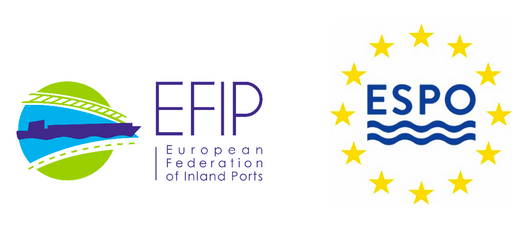
Inland waterway transport (IWT) is of vital importance for Europe’s inland ports and seaports in ensuring the connectivity between the sea and the hinterland and enhancing the sustainability of the multimodal supply chain. During the last summers, and in particular this summer, the low water levels in most of Europe’s inland waterways have created serious operational problems leading to reduced capacity, steep price increases and sometimes even the impossibility to use inland waterways. This has led to severe congestion issues in both inland and seaports. EFIP and ESPO call for a concerted answer to respond to this problem.
Many European seaports connected to inland waterways rely on IWT in order to ensure efficient and sustainable hinterland connectivity, as well as to combat road congestion around the port. At the same time, inland ports offer sustainable logistical solutions by connecting IW, rail and road. Inland waterway transport plays moreover an important role in connecting seaports with the inland ports in the hinterland. In 2021, more than 450 million and 383 million tonnes passed through the European seaports and inland ports respectively[1].
Over the last months, as a result of extreme draughts and low water levels, inland vessels were only able to transport as little as 20% of their capacity. Some stretches of the inland waterway network have even become unnavigable. The reduced capacity is leading to rising transport costs and increased congestion in both sea- and inland ports and ultimately, a reverse modal shift where goods move away from IWT to road transport.
Over the last decade the impact of climate change has become undeniably clear as droughts have resulted in long-term, very low water levels. 2018, 2019 and 2022 in particular have been characterised by persistent droughts. This resulted in a loss of business and long-term job loss[2], with the sector’s tools being stretched to their limits, transport costs rising and congestion growing. Climate modelling suggests that these kinds of droughts will become more frequent and intense[3].
Europe’s ports call on the EU, national policymakers and all relevant stakeholders to work towards a sustainable response towards increasing both the reliability and resilience of the inland shipping network.
This response should be built on 3 pillars:
1. Robust inland waterway infrastructure
The most important step in anticipation of periods of drought is to ensure that existing waterways are at an appropriate level of quality to mitigate the impact of droughts. This includes water management through use of locks and dams and hydrological engineering to address bottlenecks. Further, properly dredged and maintained waterways can help maintain the navigation status all year round and can help reduce the impact of low water periods.
The Trans-European Network – Transport (TEN-T) Revision introduces the Good Navigation Status (GNS). The GNS enables the improvement of quality and performance of the network instead of only focusing on increasing capacity. The implementation of the “navigable channel depth” concept takes into account the variety of vessels in the sector while “reference water levels” take into account the hydro-morphological qualities of any inland water section. At the same time, the GNS enables Member States to go beyond the requirements, for example with extra measures to combat droughts. This should include targeted water management and hydrological engineering. All of these tools will be needed to ensure that inland waterway sections become more resilient.
As discussions on the TEN-T proposal continue, European ports call on Member States and the European Parliament to maintain the current GNS proposal and allow for further actions to strengthen inland waterways against low water levels.
2. Cross-border cooperation and planning
Europe’s waterways are predominantly cross-border and focus on long range logistics. As such, their management and maintenance are the responsibility of all countries along their respective waterways.
In order to combat the impact of periods of drought, waterway expansion and maintenance must be coordinated at a cross-border level. Waterways are continuous water systems where a single bottleneck will be felt along the entire waterway. If one Member State ensures a high level of quality but its neighbour does not, a drought still impacts them equally.
Given that deepened cooperation is needed to address the more frequent droughts, ports call on Members States, the European Commission and the relevant river commissions to jointly present plans to address the recurring low water level periods. These plans should include infrastructural measures to strengthen the resilience of waterways and ports, innovative fairway pilot projects, logistic precautions and incentives for the shallow-water-optimisation of inland vessels.
3. Long-term resilience planning/ cooperation with other transport modes
During extreme weather events, safe and reliable navigation may prove impossible. In these periods, contingency solutions to ensure that cargo is transported quickly and efficiently on other sustainable transport modes – primarily rail – are crucial.
This requires fast transhipment from inland waterways to rail, including the planning of the replacement trip. In order to be able to offer robust contingency solutions, rail connections to the port will have to be future-proof on the entirety of the network to be able to accommodate the additional capacity needs. Additionally, this would include early warning systems predicting weather events and water levels in time for logistical chains to be altered, which could enable smart logistical systems (such as the RPIS) to support these freight shifts and to give insight into the logistics chain. Ensuring bi-modal contingency solutions and the harmonious development of rail and inland waterway supply chains has the added value of providing sustainable backup plans between IWT and rail. As shown in the Rastatt tunnel collapse of 2017, contingency plans between inland waterway and rail are the only way to ensure a continued, resilient modal shift.
Ports call on Member States together with the Commission and railway and waterway infrastructure managers to create Contingency plans that enable rail and inland waterways to support each other in times of crisis.
[1] https://www.ccnr.eu/files/documents/om/om21_II_en.pdf
[2] https://www.eur.nl/upt/nieuws/rapportage-economische-impact-laagwater
[3] https://joint-research-centre.ec.europa.eu/jrc-news/european-droughts-2018-warning-things-come-2019-06-17_en